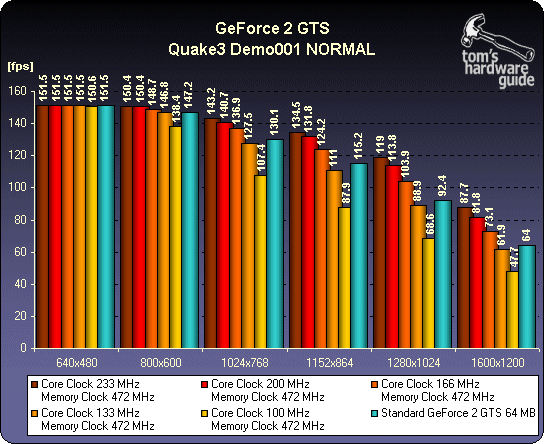ATi's New Radeon - Smart Technology Meets Brute Force
Fill Rate And Memory Bandwidth - They Belong Together!
In the recent article about 3D benchmarking I already tried to point out that today the fill rate of a 3D-chip is vastly limited by the bandwidth of its local video memory. In fact I have produced benchmarking data that shows how badly the impact of memory bandwidth is destroying the fill rate of the GeForce2 GTS chip quite a while ago. I know that Voodoo5 is suffering from this memory bandwidth problem even more and there will be an article dedicated to these surprising or even shocking findings soon. In today's article I only want to show you two charts which shall prove that ATi's idea with HyperZ is right on the money.

What I did here was to underclock the GeForce2 GTS chip to prove that with standard memory it is utterly unable to ever supply the 800 Mpixel/s that NVIDIA is claiming. What you see are 16-bit results of Quake 3 Arena scored with a standard GeForce2 GTS 64 MB card with a chip clock of 200 MHz and a memory clock of 333 MHz, compared to the results of Gainward's CARDEXpert GeForce2 GTS/400 card with its memory clocked at 472 MHz and the chip clocked at different clock speeds. The idea behind those numbers is that only the Gainward card is able to supply the claimed fill rate of 800 Mpixel/s, because it isn't restricted by its memory. A GeForce2 GTS chip clocked at 166 MHz can only supply 667 Mpixel/s, at 133 MHz it's only 533 Mpixel/s and at 100 MHz GF2 can only render 400 Mpixel/s, regardless how fast the memory is. You can see that the standard GeForce2 GTS card scores just a bit better than the Gainward card with a chip clock of 133 MHz. This proves quite nicely that in reality, a standard GeForce2 GTS card is just about able to supply some 550-600 Mpixel/s in 16-bit color. There is no way that GeForce2 GTS can achieve 800 Mpixel/s with 6ns DDR SDRAM! Have you ever wondered why GeForce2 GTS is not scoring double the frame rates of GeForce256, although it is supposed to have almost double the pixel fill rate and more than triple the texel fill rate of its predecessor? Well, here's the answer.
Stay on the Cutting Edge
Join the experts who read Tom's Hardware for the inside track on enthusiast PC tech news — and have for over 25 years. We'll send breaking news and in-depth reviews of CPUs, GPUs, AI, maker hardware and more straight to your inbox.
Current page: Fill Rate And Memory Bandwidth - They Belong Together!
Prev Page B - Radeon's HyperZ Next Page Fill Rate And Memory Bandwidth - They Belong Together! ContinuedMost Popular

